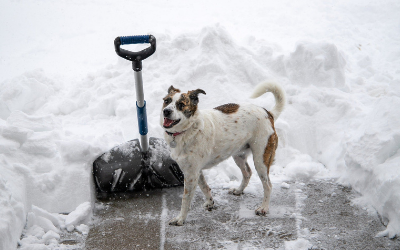
Not everyone has to experience winter’s wrath of snow, ice, rain, and windchill, but for those of us who do, winter is coming! And not everyone enjoys spending time outside in the winter months and pets may be no different, preferring to hibernate buried in a cozy blanket. However, pets still need exercise in the winter months and go outside for “bathroom breaks”. Here are some helpful tips to keep your pet safe and warm as the short days of winter set in.
Coats and sweaters. Short-haired dogs feel the cold before their long-haired counterparts, but that doesn’t mean that long-haired dogs can’t feel the cold. During cold weather, cats and dogs should be kept indoors, as they can still get frostbite and hypothermia despite their fur coats. Adding a sweater or coat for protection from rain, snow, and wind is a good idea for walks and play sessions outside. If you let your pet out on his own into your fenced yard, keep an eye on the time and don’t let him stay out too long, especially on cold and/or windy days–remember, if it’s too cold for you, it’s too cold for your pet.
Icy conditions. Ice and snow can cause issues for arthritic or senior pets. Slips and falls can occur so try to walk in areas where the snow and ice have been cleared. Rough snow and ice, along with the cold and dry conditions can be hard on the pads of your pet’s feet causing cracks and irritation. Once back home, check for cracks in your pet’s pads and contact your veterinarian if the cracks appear to be painful to touch. Ice or snowballs can build up between your pet’s toes making walking uncomfortable and painful. Check your pet’s paws regularly when outside to remove ice balls or consider booties, paw wax, or other paw protectants to help protect their paws. Keep the hair between your dog’s toes cut short to help reduce snow and ice buildup.
Ice melter and salt. Salt and other chemical ice melting agents are harsh to sensitive paws and can be toxic if consumed. Avoid using salt on your sidewalks and other walkways around your home, and instead use non-toxic, pet friendly de-icers. When you return from a walk, wipe down or wash your pet’s feet, legs, and belly to remove salt or other ice melting agents to reduce irritation to your pet’s feet and also to reduce the risk that your pet will suffer toxic effects from licking chemicals off his feet or fur.
Antifreeze. Antifreeze, also known as ethylene glycol, is used in car radiators to prevent freezing. It is also used in cottages and cabins to ensure pipes don’t freeze over the winter. Antifreeze is extremely toxic and is deadly in even small amounts, causing kidney failure if consumed. Be sure to wipe up any spills, store antifreeze far out of reach of pets, and keep pets out of harm’s way when winterizing the cottage, or better yet leave them at home. If you suspect your pet has consumed antifreeze seek immediate veterinary care.
Warm and snuggly. Keep your pet’s bed away from drafty doors or windows and position their bed in a warm area in your home. Senior pets, especially those with arthritis, may find the winter months more challenging with increased pain, stiffness, and achiness as a result of damp cold days. If your floors are cold, add another layer of insulation, like a blanket or towel underneath your pet’s bed and offer your pet a blanket to snuggle in.